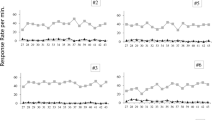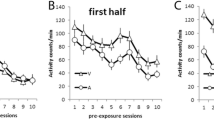The present study explored whether a similar phenomenon to stimulus over-selectivity occurred in rats, in the hope of establishing a non-human model for the autism. Rats were serially presented with two-15 seconds, two-element compound stimuli prior to the delivery of food, in an appetitive classical conditioning procedure. Each compound stimulus consisted of two lights. Once the rats had acquired a conditioned response (CR) to the stimuli, they were presented with each of the component elements separately in extinction. The rats demonstrated greater conditioning to components of the compound presented just prior to reinforcement than to the components of the temporally distant compound. However, there was a smaller difference between CRs to the components of the compound presented just prior to reinforcement (i.e. less overshadowing) than between the components of the temporally distant compound. It is suggested that rats demonstrated a form of stimulus over-selectivity, resulting in greater overshadowing of one cue by another. Such results may form the basis of a viable non-human model of this symptom of autistic spectrum disorder.




Similar content being viewed by others

References
Boucher J., Warrington E. K., (1976). Memory deficits in early infantile autism: Some similarities to the amnesiac syndromeBritish Journal of Psychology 67: 76–87
Boucher J., Lewis V., (1989) Memory impairments and communication in relatively able autistic childrenJournal of Child Psychology and Psychiatry 30: 99–122
Braff D. L., (1993). Information processing and attention dysfunctions in schizophreniaSchizophrenia Bulletin 19(2): 223–259
Gibson, E., & Reed, P. (2003). Stimulus overselectivity and early behavioural intervention for autism. Studi di Psicologia dell’Educazione
Gonzalez, H. M. (1998). Eyeblink classical conditioning in autistics. Dissertation-Abstracts International:-Section-B:-The-Sciences-and-Engineering, 59(1-B)
Hemby S. E., Sanchez M. M., & Winslow J. T., (2001). Functional genomics approaches to a primate model of autistic symptomology. Journal of Autism and Developmental Disorders, 31, 551–555
Hermelin B., O’Connor N., (1971). Psychological experiments with autistic children. Oxford: Pergamon Press
Hermelin B., O’Connor N., (1975). The recall of digits by normal, deaf and autistic children. British Journal of Psychology, 66, 203–209
Hitzemann R., (2000). Animal of psychiatric disorders and their relevance to alcoholismAlcohol Research and Health 24(3): 149–158
Koegel R. L., Wilhelm H., (1973). Selective responding to the components of multiple visual cues by autistic childrenJournal of Experimental Child Psychology 15: 442-453
Kovattana P. M., Kraemer H., (1974). Response to multiple visual cues of color, size, and form by autistic childrenJournal of Autism and Childhood Schizophrenia 4: 251-261
Lovaas O. I., (1979). Contrasting illness and behavior models for the treatment of autistic children: A historical perspectiveJournal of Autism and Development Disorders 9: 315-323
Lovaas O. I., Schreibman L., (1971). Stimulus overselectivity of autistic children in a two stimulus situationBehaviour Research and Therapy 9: 305-310
Lovaas O. I., Schreibman L., Koegel R., Rehm R., (1971) Selective responding by autistic children to multiple sensory inputJournal of Abnormal Psychology 77: 211–222
Mackintosh N. J., (1976). Overshadowing and stimulus intensityAnimal Learning and Behavior 4: 186–192
Martineau J., Garreau B., Roux S., Lelord G., (1987). Auditory evoked responses and their modifications during conditioning paradigm in autistic childrenJournal of Autism and Developmental Disorders 17: 525–539
Matthews B., Shute L., Ress P., (2000). Variables affecting stimulus control in adults with autismJournal of Intellectual and Developmental Disability 7: 13–27
Newlin R. J., LoLordo V. M., (1976). A comparison of pecking generated by serial, delay and trace autoshaping proceduresJournal of the Experimental Analysis of Behaviour 25: 227–241
Rescorla R. A., Wagner A. R., (1972). A theory of Pavlovian conditioning: Variations in the effectiveness of reinforcement and nonreinforcement. In: Black A. H., Prokasy W. F., (eds), Classical conditioning II: Current research and theory. New York: Appleton-Century-Crofts
Sears L. L., Finn P. R., Steinmetz J. E., (1994). Abnormal classical eye-blink conditioning in autismJournal of Autism and Developmental Disorders 24: 737–751
Sutherland N. S., Mackintosh N. J., (1971). Mechanisms of animal discrimination learning. New York: Academic Press
Acknowledgments
This research reported here forms part of a thesis submitted to fulfill the requirements of a doctor of philosophy degree by the first author. These data were originally presented at the Annual Conference of the Experimental Analysis of Behaviour Group UK, London, 2001. Requests for reprints should be sent to: Phil Reed, Department of Psychology, University of Wales Swansea, Singleton Park, Swansea, SA2 8PP, Wales, UK.
Author information
Authors and Affiliations
Rights and permissions
About this article
Cite this article
Gibson, E., Reed, P. Stimulus Over-selectivity in Rats. J Autism Dev Disord 35, 851–859 (2005). https://doi.org/10.1007/s10803-005-0030-9
Published:
Issue Date:
DOI: https://doi.org/10.1007/s10803-005-0030-9



